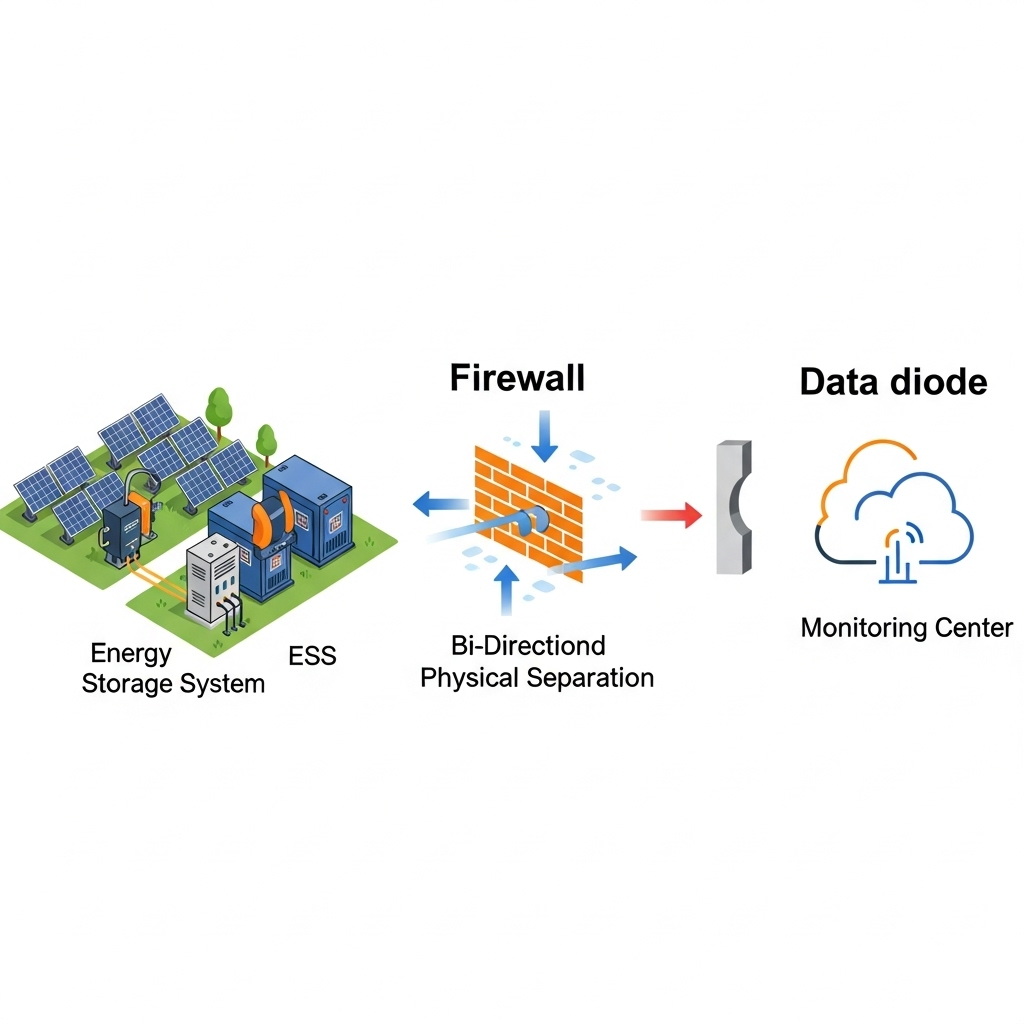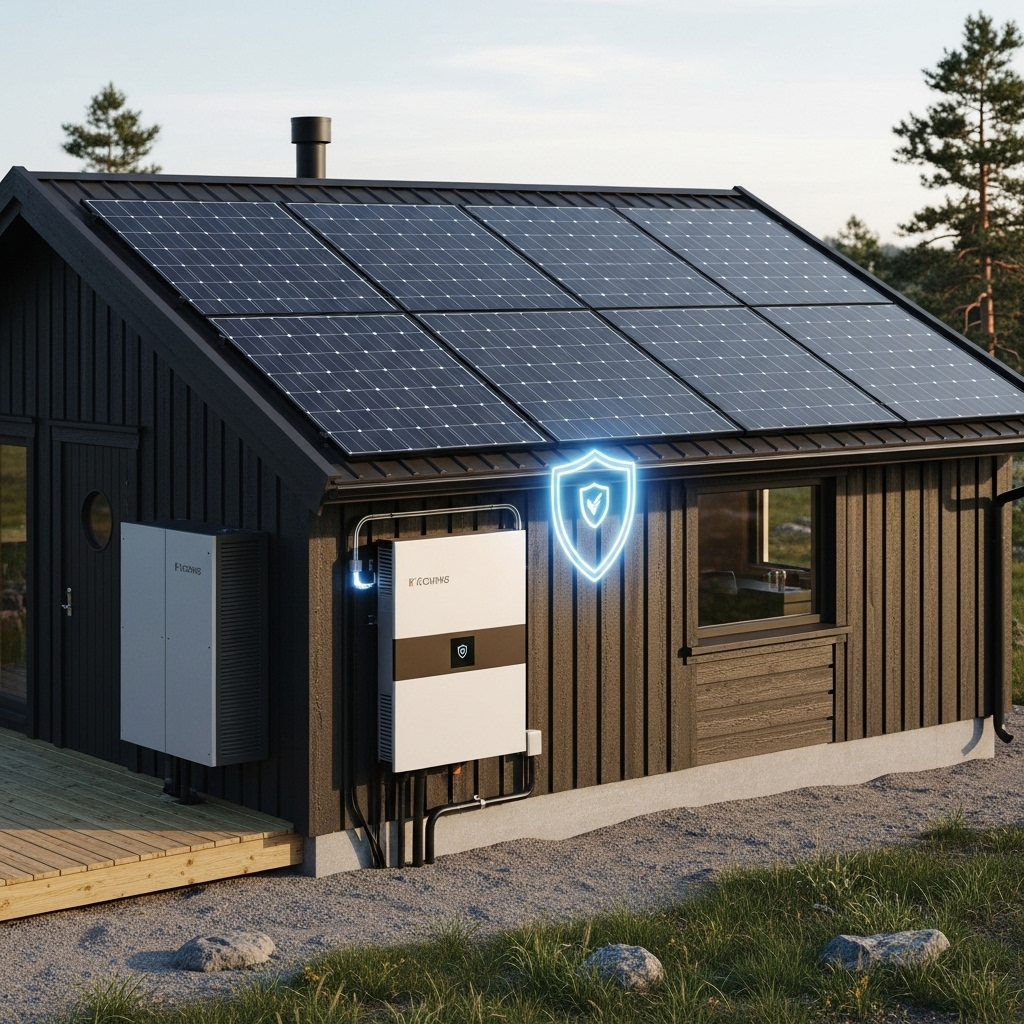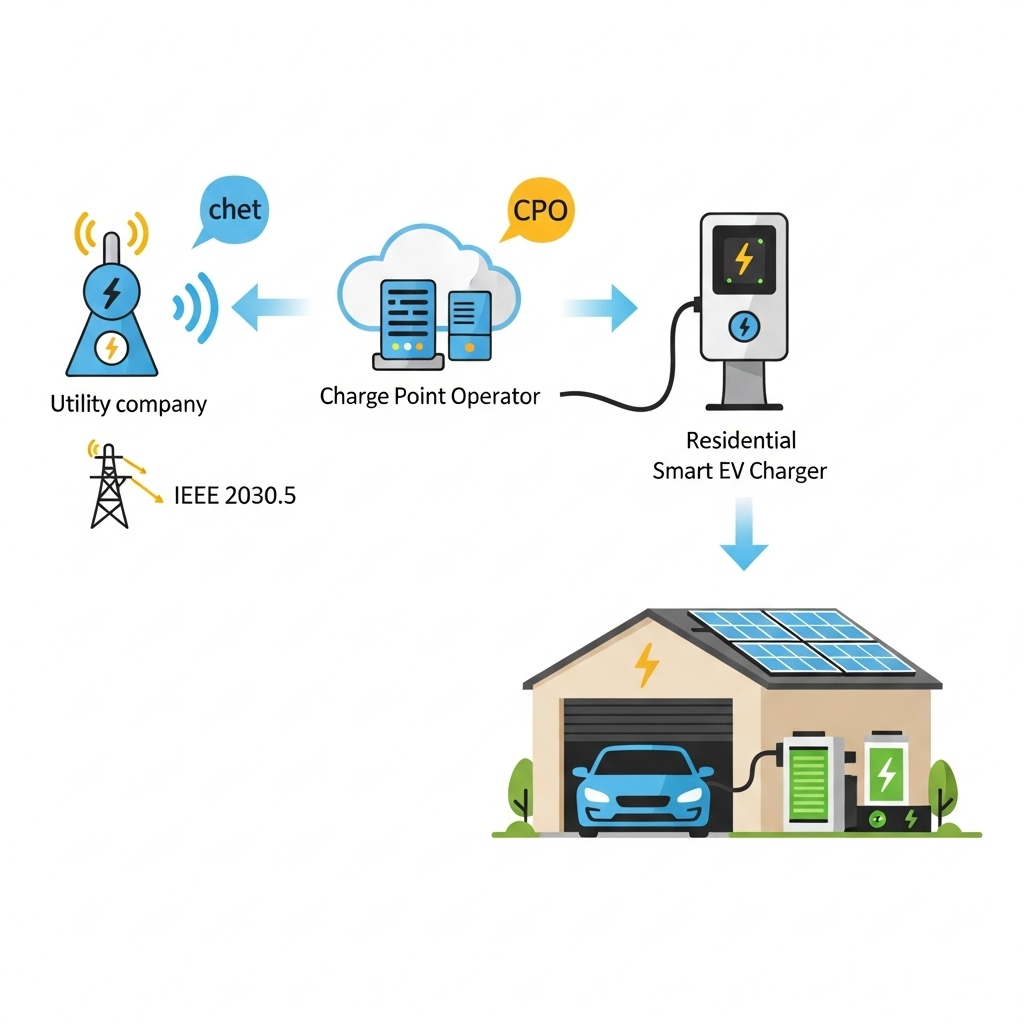As solar energy systems become more connected, their vulnerability to cyber threats grows. Every inverter and energy storage system (ESS) that communicates with the outside world presents a potential entry point for malicious actors. Protecting these critical assets requires a robust security strategy. The central challenge is allowing performance data to flow out for monitoring while blocking all unauthorized traffic from coming in. This brings us to a key decision in solar site communication security: choosing between a firewall and a data diode.
Understanding the Foundation: Firewalls in Solar Communication Security
Firewalls are a common first line of defense in network security. They act as a filter between your internal network and the outside internet, controlling what traffic is allowed to pass through based on a set of predefined rules.
How Firewalls Work: The Two-Way Gatekeepers
Think of a firewall as a security guard at a building's entrance. The guard checks the credentials of everyone trying to enter or leave. Similarly, a firewall inspects data packets traveling in both directions—inbound and outbound. It uses techniques like packet filtering and stateful inspection to decide whether to allow or block each packet. This bi-directional capability is its defining feature, designed to manage a wide range of network communications.
Strengths and Limitations for Solar Applications
Firewalls are widely available and can be a cost-effective solution for general IT security. Their flexibility allows for complex rule sets to manage traffic for various applications. However, this complexity is also a weakness. A misconfigured firewall rule can accidentally create a security hole. Because they are software-based, they are susceptible to bugs and vulnerabilities that can be exploited. For a critical solar site, the inherent two-way nature of a firewall presents a persistent risk, as any pathway in could potentially be compromised.
The Unidirectional Solution: Data Diodes Explained
For high-security environments, a different approach is needed. Data diodes provide a hardware-enforced, one-way data transfer mechanism, offering a much higher level of assurance against remote threats.
The Physics of One-Way Data Flow
A data diode is not just a set of rules; it is a physical device. The most common design uses a fiber optic link with a transmitter on one side and a receiver on the other, but no corresponding transmitter on the receiving end. This physically makes it impossible for data to flow backward. It creates a guaranteed one-way street for your data. This technology was originally developed for military and intelligence agencies to protect their most sensitive networks. According to the U.S. Department of Energy, this hardware-based approach is so effective that it is recommended by cybersecurity authorities for protecting critical infrastructure.
Why One-Way Telemetry is Critical for Inverter and ESS Security
For solar and ESS operations, the primary communication need is to send telemetry data—performance metrics, status updates, and fault alerts—to a central monitoring platform. You need to get data *out* without letting anything *in*. A data diode ensures that your inverter and ESS communication is purely for outbound monitoring. This one-way telemetry model physically blocks any inbound commands or malware, effectively eliminating the risk of a remote attacker manipulating or shutting down your power generation assets.
Head-to-Head Comparison: Data Diode vs. Firewall
Choosing the right tool depends on the specific security requirements of your network. While both can be part of a security strategy, they serve fundamentally different purposes, especially in a high-stakes environment like a solar power plant.
| Feature | Firewall | Data Diode |
|---|---|---|
| Security Principle | Software-based rule filtering | Hardware-enforced physical separation |
| Data Flow | Bi-directional (Inbound & Outbound) | Uni-directional (Outbound Only) |
| Primary Vulnerability | Software bugs, exploits, and misconfigurations | Physical tampering (often includes tamper-resistant features) |
| Complexity | High (complex rule management) | Low (simple, dedicated function) |
| Ideal Use Case | General IT network security, enterprise applications | Protecting critical OT networks (inverters, ESS) |
| Relative Cost | Lower initial cost | Higher initial cost, but decreasing |
When to Choose a Firewall
A firewall is the appropriate choice for your corporate IT network, where employees need to access the internet, send and receive emails, and use various cloud services. In these scenarios, bi-directional communication is necessary, and the risks are managed through carefully crafted security policies and continuous monitoring.
When a Data Diode is the Superior Choice
A data diode is the superior choice for protecting your Operational Technology (OT) network—the network that connects your inverters, ESS, and other control systems. When the goal is absolute prevention of remote intrusion and the only communication need is to export data, a data diode provides a level of security that a firewall cannot guarantee. As the International Energy Agency (IEA) notes, the increasing scale of solar deployment makes grid reliability paramount, and securing these assets is a non-negotiable part of that equation.
Practical Implementation and Layered Security
The most effective cybersecurity strategies often involve multiple layers of defense. Firewalls and data diodes are not mutually exclusive; they can work together to create a comprehensive security architecture.
A Hybrid Approach: Using Both for Robust Defense
A best-practice design places a data diode between your critical OT network and your corporate IT network. The data diode allows telemetry from your solar assets to pass safely to the IT network, where it can then be sent to the cloud for analysis. A firewall then protects the IT network from the wider internet. This layered approach, known as 'defense-in-depth', ensures that even if the corporate network is compromised, the critical power generation assets remain isolated and secure.
Integrating with Your Solar and Storage Performance Monitoring
Data diodes enable safe and reliable performance monitoring. They ensure that the stream of data from your inverters and batteries flows out securely to your monitoring platform. This allows asset managers to track key performance indicators without exposing the control systems to external threats. Understanding the data you are protecting is also crucial. Metrics like Depth of Discharge (DoD), State of Charge (SoC), and C-rate are vital for asset management. For a detailed breakdown of these metrics, you can review the Ultimate Reference for Solar Storage Performance, which provides valuable insights into battery health and efficiency. Securing the transmission of this data ensures its integrity and the safety of the system it represents.
Securing Your Energy Future
In the debate between data diodes and firewalls, the context is everything. Firewalls are versatile tools for managing the two-way traffic of typical IT environments. Data diodes, however, are specialists, built for one purpose: to create an unbreachable, one-way exit for data from a secure environment. For protecting the communication of solar inverters and energy storage systems, the physical separation offered by a data diode provides the highest level of security against remote cyberattacks. As decentralized energy resources grow in importance, as highlighted by organizations like IRENA, adopting hardware-level cybersecurity is a fundamental step toward building a truly resilient and secure energy infrastructure for the future.
Frequently Asked Questions
Can a firewall be configured to act like a data diode?
While you can create highly restrictive firewall rules to block all inbound traffic on a specific connection, it is not a true equivalent. A firewall remains a software-based, bi-directional device that is still processing inbound packets, even if it just drops them. It is susceptible to software bugs, zero-day exploits, and human error in configuration. A data diode's security is guaranteed by its physical hardware design, which has no pathway for inbound data to cross.
Are data diodes expensive?
Historically, data diodes were high-cost devices reserved for government and military use. However, as a report from the U.S. Department of Energy highlights, innovation has led to the development of lower-cost data diodes specifically for industrial and commercial sectors like solar energy. When you weigh the initial cost against the potential financial and grid-stability impact of a successful cyberattack on a power generation facility, the investment in a data diode becomes a sound business decision.
Do I still need a firewall if I use a data diode?
Yes, in almost all enterprise environments. A data diode is used to protect a very specific and critical data path (e.g., from your OT network to your IT network). You will still need firewalls to protect your broader corporate IT network, which handles employee internet access, email, and other services requiring bi-directional communication. They play different but complementary roles in a layered cybersecurity strategy.





Leave a comment
All comments are moderated before being published.
This site is protected by hCaptcha and the hCaptcha Privacy Policy and Terms of Service apply.